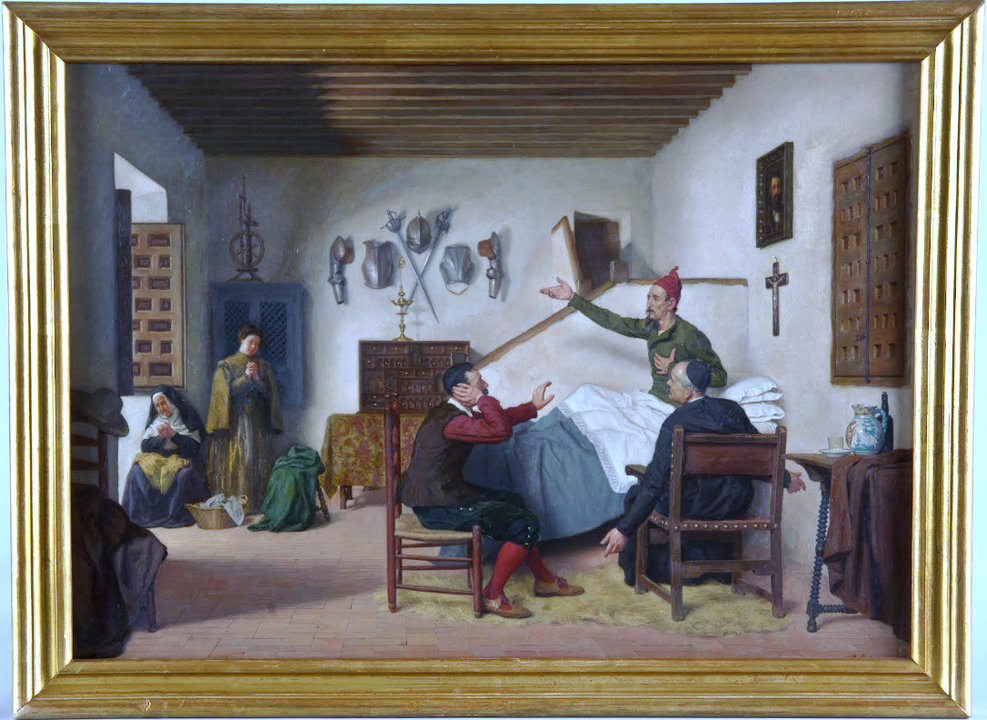Museo Casa de Cervantes, located in city Valladolid of autonomous community Castile and Leon, Spain, is the house where the novelist, poet and playwright Miguel de Cervantes lived in the year 1605. Currently it is a museum. The building was declared a Bien de Interés Cultural on 9 June 1958.
The Museum is located in the building occupied by the writer Miguel de Cervantes during his stay in Valladolid between 1604 and 1606. The Cervantes´s stay in Valladolid coincided with the publication of the first edition of Don Quixote, in 1605. Inside it attempts to recreate the atmosphere that the writer could breathe quietly in a house decorated, according to the possibilities of a seventeenth-century Spanish nobleman.
In the year 1600 the court of Philip III moved to Valladolid, until 1606 when he returned to Madrid. During those six years Valladolid underwent a series of improvements and also gained much in the cultural and financial aspect, but lacked lodging. In 1602, in what was called Acera del Rastro, the construction of five pairs of houses began, one of which, or rather part of it, was the one that inhabited Cervantes in 1605. The promoter of the houses was Juan De las Navas, mayor of the town council and also administrator of the neighboring butchers and the service of velería. The houses were located in front of the wooden bridge over a branch of the Esgueva River (a tributary of the Pisuerga River, which in those days passed by the Acera del Rastro, in what is today the street of Miguel Íscar).
It was known from ancient times that Cervantes had lived for some years in Valladolid and that he had come to this city on matters of work and related to the removal of Felipe III’s court. Cervantes had been tax collector arrears (alcabalas) and commissioner of the Navy; Since, according to the same document that destroyed the identification of the house, a Genoese Assentista and a Sevillian banker visited him for business, presumably he worked in the bank as an accountant. But for centuries it was all assumptions and nothing was certain about the exact place of his house. Until at the end of the eighteenth century the previous information was found, which is a remarkable document about the life of Cervantes: it was possible to find out exactly the place of the house that lived during his stay in the Castilian city because he is clearly named to him And his family and describes exactly where his home was located, and read clearly and in detail the lives they all had.
The wounded was transported to the house that was attached to the one of Cervantes, reason why all the neighbors of those properties had to go to testify, among them Cervantes and his family.
Towards the year 1860 arrived the veteran Jose Santa Maria de Hita of Valladolid that investigated in more depth than had done other illustrious personages previously. The 29 of April of 1862 already had in his power all the results of the investigation and the certainty of having given exactly with the house of Cervantes.
In 1912 the Marquis of la Vega Inclán, Royal Commissioner of Turism, and Mr. Archer Huntington, president of The Hispanic Society of America, buy the buildings corresponding to Cervantes´s house and those adjoinings, to preserve all them of the wreck, with the support of the King of Spain Alfonso XIII. Their intention was to found a Library and a Museum in honor of Miguel de Cervantes. First was the Biblioteca Popular Cervantina in 1916, and then the museum in 1948.
All these tracks were very easy to follow by the illustrious brewer. Since then the house of Cervantes has not changed practically anything and the four other new houses are conserved next to her. There was a time when the house was forgotten and about to collapse to make a modern expansion, but could be avoided thanks to the intervention of the great patron and also Cervantes Marquis de la Vega Inclán, who got the repairs and relevant purchases with his own He also helps with the help given by King Alfonso XIII (who later gave his contribution to the Spanish State), and the President of the Hispanic Society of New York, Archer Milton Huntington. Thus the house of Valladolid, which for some years housed Cervantes and his family, was preserved and made into a museum, and in which works such as The Dog Colloquium, The Misleading Marriage, The Illustrious Mop, The Licentiate Stained Glass, and a few more were written. .
In the garden were installed the remains of the old facade of the Hospital of the Resurrection, which in the time of Cervantes was next to his house and which is the scene of one of his Exemplary Novelas, Coloquio de los perros.
In 2005, on the occasion of the IV Centenary of the first edition of Don Quixote de la Mancha, a series of reforms and cleaning of the property and its garden were carried out.
At present it is the Casa de Cervantes Museum, managed by the Ministry of Culture. In addition to the visit of the curious and tourists, offers literary days every month and tributes to Cervantes every April 23.
